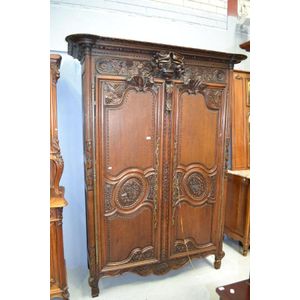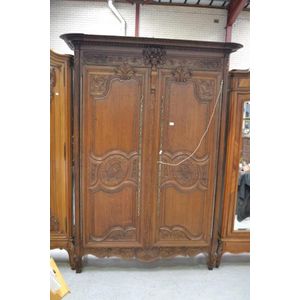French Louis XV Carved Oak Armoire
Impressive antique 19th century French Louis XV carved oak two door armoire, carved in high relief to the central top with a basket of flowers, the door tops carved in high relief with leafy scrolls, and continuous carved panels of low relief fine carving, shaped apron below, approx 258 cm high, 146 cm wide
You must be a subscriber, and be logged in to view price and dealer details.
Subscribe Now to view actual auction price for this item
When you subscribe, you have the option of setting the currency in which to display prices to $Au, $US, $NZ or Stg.
This item has been sold, and the description, image and price are for reference purposes only.
- Oak - Native to Europe and England, oak has been used for joinery, furniture and building since the beginning of the medieval civilisation. It is a pale yellow in colour when freshly cut and darkens with age to a mid brown colour.
Oak as a furniture timber was superceded by walnut in the 17th century, and in the 18th century by mahogany,
Semi-fossilised bog oak is black in colour, and is found in peat bogs where the trees have fallen and been preserved from decay by the bog. It is used for jewellery and small carved trinkets.
Pollard oak is taken from an oak that has been regularly pollarded, that is the upper branches have been removed at the top of the trunk, result that new branches would appear, and over time the top would become ball-like. . When harvested and sawn, the timber displays a continuous surface of knotty circles. The timber was scarce and expensive and was used in more expensive pieces of furniture in the Regency and Victorian periods. - Panels - Timber pieces, usually of well-figured wood either recessed or applied over the frames of doors and as decoration elsewhere in the carcase of cabinet furniture. The panels may take a variety of shapes rectangular, square, shield shape, oval, half-round or in the form of Egyptian pylons.
- Scrolls - Serpentine-shaped forms, used in cabinet construction and decoration for centuries. The scroll appears in legs, feet, as carving in chair brackets, chair rails and arms. The deeper and more spontaneous the carving is, the earlier the piece is likely to be. The Regency or 'Thomas Hope' scroll, used on pediments and sideboard backs, consists of two scrolls on the horizontal plane, placed back to back in a mirror image, and sometimes decorated with a variety of carved and/or applied ornament, such as shells, foliate and other motifs. Chippendale-style furniture is often distinguished by two corresponding scrolls in the form of a 'C' in the upper splat or where chair legs join the seat rail.
- Apron - A decorative wooden panel that sits underneath the top surface of a table or chair, and unites the top of the piece with the legs, running at right angles to the underside. On carcase furniture such as a chest or wardrobe, the apron sits below the drawers or doors and attaches to the legs.
On carcase furniture without legs the panel under the drawers or doors sits on the floor and is termed a plinth.
An apron can provide a decorative touch to an otherwise unadorned piece of furniture and at the same time provide structural support and strength. They can be carved or pierced and quite elaborate.
This item has been included into following indexes:
Visually similar items

Antique French Normandy carved oak two door armoire, approx 238 cm high, 178 cm wide, 68 cm deep
Sold by
in
for
You can display prices in $Au, $US, $NZ or Stg.

Vintage French Louis XV style oak display cabinet, approx 201 cm high, 76 cm wide, 40 cm deep
Sold by
in
for
You can display prices in $Au, $US, $NZ or Stg.

Antique French Normandy carved oak two armoire, approx 230 cm high, 147 cm wide, 54 cm deep
Sold by
in
for
You can display prices in $Au, $US, $NZ or Stg.

Antique 19th century French carved oak Normandy two door armoire, approx. 231 cm high, 141 cm wide
Sold by
in
for
You can display prices in $Au, $US, $NZ or Stg.
